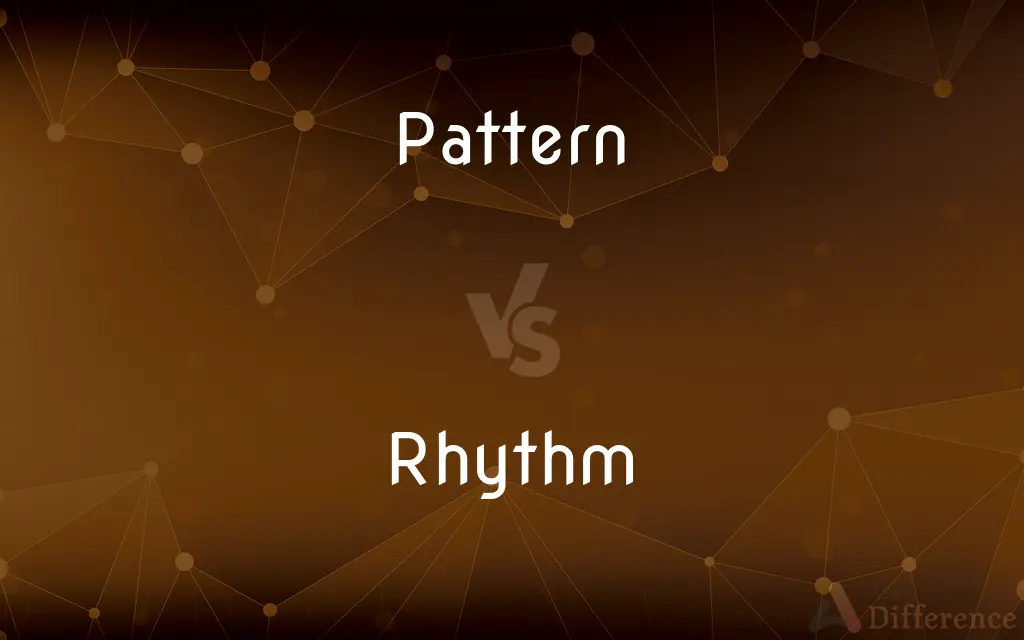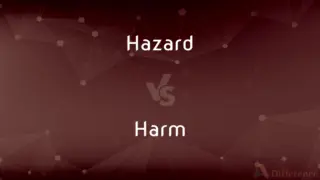Pattern vs. Rhythm — What's the Difference?
By Tayyaba Rehman & Urooj Arif — Updated on April 3, 2024
Pattern refers to a repeating design or sequence, while rhythm denotes a sequence of sounds or movements in time.

Difference Between Pattern and Rhythm
Table of Contents
ADVERTISEMENT
Key Differences
Patterns are arrangements or sequences that repeat in a predictable manner, often found in visual designs, behaviors, or data. They can be identified by their repetition of elements or structures across different contexts. Rhythms, however, are specifically related to time and involve the sequence and timing of sounds, movements, or events, emphasizing the flow and tempo within a sequence.
While patterns focus on the repetition and arrangement of elements, rhythm introduces the dimension of time, focusing on how these elements are spaced and how they occur in sequence. A pattern can exist without a temporal element, such as a tiled design, whereas rhythm inherently involves the timing and duration of elements, such as in music or speech.
Patterns can be static, offering a snapshot of repetition that does not change over time. Rhythms, by contrast, are dynamic and involve the progression and variation of elements over time, creating a sense of movement and progression. This distinction highlights how patterns provide structure and predictability, while rhythms contribute a sense of timing and pace.
In the realm of art and design, patterns are used to create visual interest and structure through the repeated use of colors, shapes, or lines. In music and dance, rhythm is crucial for establishing tempo, beat, and flow, guiding the timing of musical notes or dance steps. This illustrates how both concepts, while related, serve different purposes in various contexts.
Patterns and rhythms together can enrich experiences and perceptions, especially in arts and culture. A pattern in a piece of fabric can give it visual appeal, while rhythm in music adds emotional depth and temporal structure. Understanding the interplay between pattern and rhythm enhances appreciation for both the visual and temporal arts, showcasing their combined impact on aesthetic and sensory experiences.
ADVERTISEMENT
Comparison Chart
Definition
Repeating design or sequence.
Sequence of sounds or movements in time.
Key Focus
Repetition and arrangement of elements.
Timing, sequence, and duration of elements.
Nature
Can be static, without involving time.
Inherently dynamic, involving the flow and tempo of elements.
Role in Arts
Provides structure and predictability in visual designs.
Establishes tempo and flow in music and dance.
Examples
Tiled designs, wallpaper patterns, behavior patterns.
Musical beats, speech cadences, dance sequences.
Compare with Definitions
Pattern
Repeating sequence in designs.
The wallpaper featured a floral pattern.
Rhythm
Sequence of sounds or movements over time.
The song had a fast, upbeat rhythm.
Pattern
Provides structure and order.
Genetic patterns determine traits.
Rhythm
Involves the timing and pace of events.
The poet's use of rhythm enhanced the reading.
Pattern
Found across various contexts.
Patterns in consumer behavior help marketers.
Rhythm
Creates a sense of movement and progression.
The rhythm of the waves soothed him.
Pattern
Observable in behaviors or data.
Bird migration patterns are predictable.
Rhythm
Essential in music and dance for tempo.
Dancers follow the rhythm to maintain synchrony.
Pattern
Can be visual, behavioral, or conceptual.
The pattern of stars in the sky forms constellations.
Rhythm
Dynamic, reflecting changes over time.
The changing rhythms of the city life fascinated her.
Pattern
A pattern is a regularity in the world, in human-made design, or in abstract ideas. As such, the elements of a pattern repeat in a predictable manner.
Rhythm
Rhythm (from Greek ῥυθμός, rhythmos, "any regular recurring motion, symmetry"—Liddell and Scott 1996) generally means a "movement marked by the regulated succession of strong and weak elements, or of opposite or different conditions" (Anon. 1971, 2537).
Pattern
A usually repeating artistic or decorative design
A paisley pattern.
Rhythm
Movement or variation characterized by the regular recurrence or alternation of different quantities or conditions
The rhythm of the tides.
Pattern
A natural or accidental arrangement or sequence
The pattern of rainfall over the past year.
Rhythm
The patterned, recurring alternations of contrasting elements of sound or speech.
Pattern
A plan, diagram, or model to be followed in making things
A dress pattern.
Rhythm
The patterning of musical sound, as by differences in the timing, duration, or stress of consecutive notes.
Pattern
A model or original used for imitation or as an archetype.
Rhythm
A specific kind of such patterning
A waltz rhythm.
Pattern
A composite of traits or features characteristic of an individual or a group
One's pattern of behavior.
Rhythm
A group of instruments supplying the rhythm in a band.
Pattern
Form and style in an artistic work or body of artistic works.
Rhythm
The pattern or flow of sound created by the arrangement of stressed and unstressed syllables in accentual verse or of long and short syllables in quantitative verse.
Pattern
The configuration of gunshots upon a target that is used as an indication of skill in shooting.
Rhythm
The similar but less formal sequence of sounds in prose.
Pattern
The distribution and spread, around a targeted region, of spent shrapnel, bomb fragments, or shot from a shotgun.
Rhythm
A specific kind of metrical pattern or flow
Iambic rhythm.
Pattern
Enough material to make a complete garment.
Rhythm
The sense of temporal development created in a work of literature or a film by the arrangement of formal elements such as the length of scenes, the nature and amount of dialogue, or the repetition of motifs.
Pattern
A test pattern.
Rhythm
A regular or harmonious pattern created by lines, forms, and colors in painting, sculpture, and other visual arts.
Pattern
The flight path of an aircraft about to land
A flight pattern.
Rhythm
The pattern of development produced in a literary or dramatic work by repetition of elements such as words, phrases, incidents, themes, images, and symbols.
Pattern
(Football) A pass pattern.
Rhythm
Procedure or routine characterized by regularly recurring elements, activities, or factors
The rhythm of civilization.
The rhythm of the lengthy negotiations.
Pattern
To make, mold, or design by following a pattern
We patterned this plan on the previous one. My daughter patterned her military career after her father's.
Rhythm
The variation of strong and weak elements (such as duration, accent) of sounds, notably in speech or music, over time; a beat or meter.
Dance to the rhythm of the music.
Pattern
To cover or ornament with a design or pattern.
Rhythm
A specifically defined pattern of such variation.
Most dances have a rhythm as distinctive as the Iambic verse in poetry
Pattern
To make a pattern.
Rhythm
A flow, repetition or regularity.
Once you get the rhythm of it, the job will become easy.
Pattern
Model, example.
Rhythm
The tempo or speed of a beat, song or repetitive event.
We walked with a quick, even rhythm.
Pattern
Something from which a copy is made; a model or outline.
Rhythm
The musical instruments which provide rhythm (mainly; not or less melody) in a musical ensemble.
The Baroque term basso continuo is virtually equivalent to rhythm
Pattern
Someone or something seen as an example to be imitated; an exemplar.
Rhythm
A regular quantitative change in a variable (notably natural) process.
The rhythm of the seasons dominates agriculture as well as wildlife
Pattern
A copy.
Rhythm
Controlled repetition of a phrase, incident or other element as a stylistic figure in literature and other narrative arts; the effect it creates.
The running gag is a popular rhythm in motion pictures and theater comedy
Pattern
A sample; of coins, an example which was struck but never minted.
Rhythm
A person's natural feeling for rhythm.
That girl's got rhythm, watch her dance!
Pattern
A representative example.
Rhythm
In the widest sense, a dividing into short portions by a regular succession of motions, impulses, sounds, accents, etc., producing an agreeable effect, as in music poetry, the dance, or the like.
Pattern
(US) The material needed to make a piece of clothing.
Rhythm
Movement in musical time, with periodical recurrence of accent; the measured beat or pulse which marks the character and expression of the music; symmetry of movement and accent.
Pattern
(textiles) The paper or cardboard template from which the parts of a garment are traced onto fabric prior to cutting out and assembling.
Rhythm
A division of lines into short portions by a regular succession of arses and theses, or percussions and remissions of voice on words or syllables.
Pattern
A full-sized model around which a mould of sand is made, to receive the melted metal. It is usually made of wood and in several parts, so as to be removed from the mould without damage.
Rhythm
The harmonious flow of vocal sounds.
Pattern
(computing) A text string containing wildcards, used for matching.
There were no files matching the pattern
*.txt.Rhythm
The basic rhythmic unit in a piece of music;
The piece has a fast rhythm
The conductor set the beat
Pattern
A design pattern.
Rhythm
Recurring at regular intervals
Pattern
Coherent or decorative arrangement.
Rhythm
An interval during which a recurring sequence of events occurs;
The neverending cycle of the seasons
Pattern
A design, motif or decoration, especially formed from regular repeated elements.
Rhythm
The arrangement of spoken words alternating stressed and unstressed elements;
The rhythm of Frost's poetry
Pattern
A naturally-occurring or random arrangement of shapes, colours etc. which have a regular or decorative effect.
Rhythm
Natural family planning in which ovulation is assumed to occur 14 days before the onset of a period (the fertile period would be assumed to extend from day 10 through day 18 of her cycle)
Pattern
The given spread, range etc. of shot fired from a gun.
Pattern
A particular sequence of events, facts etc. which can be understood, used to predict the future, or seen to have a mathematical, geometric, statistical etc. relationship.
Pattern
(linguistics) An intelligible arrangement in a given area of language.
Pattern
A sequence of notes, percussion etc. in a tracker module, usable once or many times within the song.
Pattern
To apply a pattern.
Pattern
To make or design (anything) by, from, or after, something that serves as a pattern; to copy; to model; to imitate.
Pattern
To follow an example.
Pattern
To fit into a pattern.
Pattern
(transitive) To serve as an example for.
Pattern
To observe an animal closely over time in order to discern its habitual movements and behaviours.
Pattern
(MLE) To arrange, to organise, to fix.
Pattern
Of or in accordance with a usual pattern, or type; model; ideal.
Pattern
Anything proposed for imitation; an archetype; an exemplar; that which is to be, or is worthy to be, copied or imitated; as, a pattern of a machine.
I will be the pattern of all patience.
Pattern
A part showing the figure or quality of the whole; a specimen; a sample; an example; an instance.
He compares the pattern with the whole piece.
Pattern
Stuff sufficient for a garment; as, a dress pattern.
Pattern
Figure or style of decoration; design; as, wall paper of a beautiful pattern.
Pattern
Something made after a model; a copy.
The patterns of things in the heavens.
Pattern
Anything cut or formed to serve as a guide to cutting or forming objects; as, a dressmaker's pattern.
Pattern
A full-sized model around which a mold of sand is made, to receive the melted metal. It is usually made of wood and in several parts, so as to be removed from the mold without injuring it.
Pattern
A recognizable characteristic relationship or set of relationships between the members of any set of objects or actions, or the properties of the members; also, the set having a definable relationship between its members.
Pattern
A diagram showing the distribution of the pellets of a shotgun on a vertical target perpendicular to the plane of fire.
Pattern
The recommended flight path for an airplane to follow as it approaches an airport for a landing. Same as landing pattern.
Pattern
An image or diagram containing lines, usually horizontal, vertical, and diagonal, sometimes of varying widths, used to test the resolution of an optical instrument or the accuracy of reproduction of image copying or transmission equipment. Same as test pattern.
Pattern
To make or design (anything) by, from, or after, something that serves as a pattern; to copy; to model; to imitate.
[A temple] patterned from that which Adam reared in Paradise.
Pattern
To serve as an example for; also, to parallel.
Pattern
A perceptual structure;
The composition presents problems for students of musical form
A visual pattern must include not only objects but the spaces between them
Pattern
A customary way of operation or behavior;
It is their practice to give annual raises
They changed their dietary pattern
Pattern
A decorative or artistic work;
The coach had a design on the doors
Pattern
Something regarded as a normative example;
The convention of not naming the main character
Violence is the rule not the exception
His formula for impressing visitors
Pattern
A model considered worthy of imitation;
The American constitution has provided a pattern for many republics
Pattern
Something intended as a guide for making something else;
A blueprint for a house
A pattern for a skirt
Pattern
The path that is prescribed for an airplane that is preparing to land at an airport;
The traffic patterns around O'Hare are very crowded
They stayed in the pattern until the fog lifted
Pattern
Graphical representation (in polar or cartesian coordinates) of the spatial distribution of radiation from an antenna as a function of angle
Pattern
Plan or create according to a model or models
Pattern
Form a pattern;
These sentences pattern like the ones we studied before
Common Curiosities
What is a pattern?
A pattern is a repeating sequence or design that can be identified by its predictable arrangement of elements.
How is rhythm different from a pattern?
Rhythm involves the timing, sequence, and pace of elements over time, focusing on the flow and tempo, unlike patterns, which are about the repetition of elements regardless of timing.
Can a pattern have rhythm?
Yes, especially in contexts where timing or sequence is involved, like in music or poetry, where the pattern of sounds creates a rhythm.
Why is rhythm important in music?
Rhythm establishes the tempo and flow of music, guiding the timing of musical notes and the overall feeling of the piece.
What role does rhythm play in dance?
Rhythm dictates the timing and sequence of dance steps, ensuring dancers move in sync with the music.
What is an example of rhythm in nature?
The rhythmic cycle of the tides or the seasonal patterns that dictate animal migration are natural rhythms.
Can rhythm exist without sound?
Yes, rhythm can involve any repetitive movement or sequence in time, not just sound, such as the rhythmic movement of a pendulum.
How do patterns affect design?
Patterns add visual interest and structure to designs, creating a sense of order and harmony through repeated elements.
Can patterns be found in language?
Yes, linguistic patterns, such as syntax and phonetic patterns, are fundamental to the structure and understanding of language.
How do patterns influence behavior?
Behavioral patterns, such as habits, shape routines and can predict actions, helping in understanding and modifying behaviors.
How can understanding patterns benefit learning?
Recognizing patterns can enhance cognitive skills, aiding in problem-solving and prediction in various fields.
How do patterns and rhythms enhance cultural experiences?
They contribute to cultural identity and expression through traditional dances, music, art, and rituals, reflecting the unique characteristics of cultures.
How do patterns and rhythms interact in art?
In art, patterns provide a visual framework, while rhythms add movement and tempo, enriching the sensory experience.
Is rhythm always deliberate in creation?
Not always; rhythm can emerge naturally, as in speech patterns or in the cadence of walking.
What makes a rhythm complex?
Complexity in rhythm can come from variations in tempo, beat, and syncopation, adding depth to musical compositions.
Share Your Discovery

Previous Comparison
Hazard vs. Harm
Next Comparison
Wish vs. DreamAuthor Spotlight
Written by
Tayyaba RehmanTayyaba Rehman is a distinguished writer, currently serving as a primary contributor to askdifference.com. As a researcher in semantics and etymology, Tayyaba's passion for the complexity of languages and their distinctions has found a perfect home on the platform. Tayyaba delves into the intricacies of language, distinguishing between commonly confused words and phrases, thereby providing clarity for readers worldwide.
Co-written by
Urooj ArifUrooj is a skilled content writer at Ask Difference, known for her exceptional ability to simplify complex topics into engaging and informative content. With a passion for research and a flair for clear, concise writing, she consistently delivers articles that resonate with our diverse audience.














































